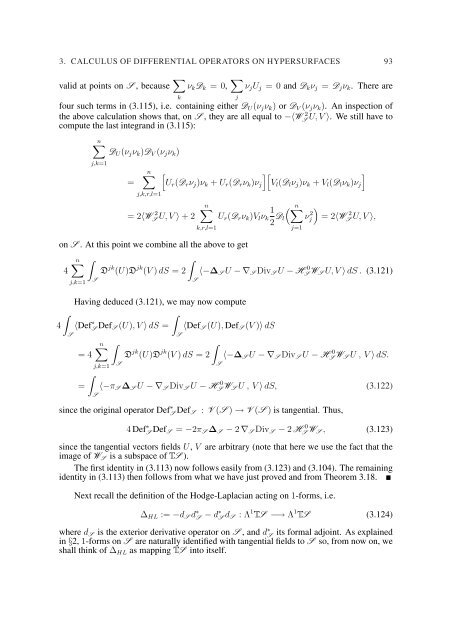EQUATIONS OF ELASTIC HYPERSURFACES
EQUATIONS OF ELASTIC HYPERSURFACES
EQUATIONS OF ELASTIC HYPERSURFACES
Create successful ePaper yourself
Turn your PDF publications into a flip-book with our unique Google optimized e-Paper software.
3. CALCULUS <strong>OF</strong> DIFFERENTIAL OPERATORS ON <strong>HYPERSURFACES</strong> 93<br />
valid at points on S , because ∑ k<br />
ν k D k = 0, ∑ j<br />
ν j U j = 0 and D k ν j = D j ν k . There are<br />
four such terms in (3.115), i.e. containing either D U (ν j ν k ) or D V (ν j ν k ). An inspection of<br />
the above calculation shows that, on S , they are all equal to −〈WS 2 U, V 〉. We still have to<br />
compute the last integrand in (3.115):<br />
n∑<br />
D U (ν j ν k )D V (ν j ν k )<br />
j,k=1<br />
=<br />
n∑<br />
j,k,r,l=1<br />
= 2〈W 2 S U, V 〉 + 2<br />
[U r (D r ν j )ν k + U r (D r ν k )ν j<br />
][V l (D l ν j )ν k + V l (D l ν k )ν j<br />
]<br />
n∑<br />
k,r,l=1<br />
on S . At this point we combine all the above to get<br />
4<br />
n∑<br />
∫<br />
j,k=1<br />
S<br />
1<br />
( n∑<br />
U r (D r ν k )V l ν k<br />
2 D l<br />
j=1<br />
ν 2 j<br />
)<br />
= 2〈WS 2 U, V 〉,<br />
∫<br />
D jk (U)D jk (V ) dS = 2 〈−∆ S U − ∇ S Div S U − HS 0 W S U, V 〉 dS . (3.121)<br />
S<br />
Having deduced (3.121), we may now compute<br />
∫<br />
∫<br />
4 〈Def ∗ S Def S (U), V 〉 dS = 〈Def S (U), Def S (V )〉 dS<br />
S<br />
S<br />
n∑<br />
∫<br />
∫<br />
= 4 D jk (U)D jk (V ) dS = 2 〈−∆ S U − ∇ S Div S U − HS 0 W S U , V 〉 dS.<br />
∫<br />
=<br />
j,k=1<br />
S<br />
S<br />
S<br />
〈−π S ∆ S U − ∇ S Div S U − H 0<br />
S W S U , V 〉 dS, (3.122)<br />
since the original operator Def ∗ S Def S<br />
: V (S ) → V (S ) is tangential. Thus,<br />
4 Def ∗ S Def S = −2π S ∆ S − 2 ∇ S Div S − 2 H 0<br />
S W S , (3.123)<br />
since the tangential vectors fields U, V are arbitrary (note that here we use the fact that the<br />
image of W S is a subspace of TS ).<br />
The first identity in (3.113) now follows easily from (3.123) and (3.104). The remaining<br />
identity in (3.113) then follows from what we have just proved and from Theorem 3.18.<br />
Next recall the definition of the Hodge-Laplacian acting on 1-forms, i.e.<br />
∆ HL := −d S d ∗ S − d ∗ S d S : Λ 1 TS −→ Λ 1 TS (3.124)<br />
where d S is the exterior derivative operator on S , and d ∗ S its formal adjoint. As explained<br />
in §2, 1-forms on S are naturally identified with tangential fields to S so, from now on, we<br />
shall think of ∆ HL as mapping TS into itself.

















